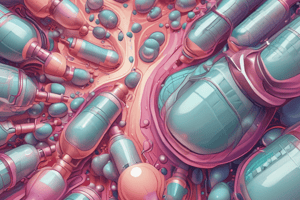Podcast
Questions and Answers
What are monomers?
What are monomers?
- Long chains of sugar units
- Large units of molecules
- Polysaccharides
- Components of larger molecules (correct)
How are monomers joined together to form polymers?
How are monomers joined together to form polymers?
- By adding a water molecule
- Through a condensation reaction (correct)
- By hydrolysis
- By breaking chemical bonds
What type of bond is formed in a condensation reaction to join monosaccharides together?
What type of bond is formed in a condensation reaction to join monosaccharides together?
- Covalent bond
- Peptide bond
- Hydrogen bond
- Glycosidic bond (correct)
How many carbon atoms are there in a glucose molecule?
How many carbon atoms are there in a glucose molecule?
Which of the following is true about alpha and beta glucose?
Which of the following is true about alpha and beta glucose?
What is the main substrate for respiration?
What is the main substrate for respiration?
What is the purpose of glycolipids on the cell surface membrane?
What is the purpose of glycolipids on the cell surface membrane?
How can the presence of lipids be detected using an emulsion test?
How can the presence of lipids be detected using an emulsion test?
What functional groups are present in amino acids?
What functional groups are present in amino acids?
How are amino acids joined together in proteins?
How are amino acids joined together in proteins?
What determines the structure of proteins?
What determines the structure of proteins?
What type of bond is formed between amino acids in a dipeptide?
What type of bond is formed between amino acids in a dipeptide?
What determines a protein's function in the end?
What determines a protein's function in the end?
Which type of bond is easily broken by changes in pH and is weaker than disulfide bridges in proteins?
Which type of bond is easily broken by changes in pH and is weaker than disulfide bridges in proteins?
What is the 3D shape of a protein known as?
What is the 3D shape of a protein known as?
Which test can be used to detect the presence of peptide bonds in proteins?
Which test can be used to detect the presence of peptide bonds in proteins?
What type of proteins are enzymes classified as in terms of shape?
What type of proteins are enzymes classified as in terms of shape?
What weak interactions lead to the formation of alpha helices and beta pleated sheets in proteins?
What weak interactions lead to the formation of alpha helices and beta pleated sheets in proteins?
Flashcards
What are monomers?
What are monomers?
The individual components that make up larger molecules.
How are monomers joined?
How are monomers joined?
Monomers join through a condensation reaction, releasing a water molecule.
Bond joining monosaccharides?
Bond joining monosaccharides?
A glycosidic bond is formed when monosaccharides are joined together.
Carbon atoms in glucose?
Carbon atoms in glucose?
Signup and view all the flashcards
Alpha vs. Beta glucose?
Alpha vs. Beta glucose?
Signup and view all the flashcards
Main respiration substrate?
Main respiration substrate?
Signup and view all the flashcards
Purpose of glycolipids?
Purpose of glycolipids?
Signup and view all the flashcards
Detecting lipids?
Detecting lipids?
Signup and view all the flashcards
Amino acid groups?
Amino acid groups?
Signup and view all the flashcards
How are amino acids linked?
How are amino acids linked?
Signup and view all the flashcards
Determinants of protein structure?
Determinants of protein structure?
Signup and view all the flashcards
Bond in a dipeptide?
Bond in a dipeptide?
Signup and view all the flashcards
Determines protein's function?
Determines protein's function?
Signup and view all the flashcards
Ionic bonds in proteins?
Ionic bonds in proteins?
Signup and view all the flashcards
Protein's 3D shape?
Protein's 3D shape?
Signup and view all the flashcards
Detecting peptide bonds?
Detecting peptide bonds?
Signup and view all the flashcards
Enzymes shape?
Enzymes shape?
Signup and view all the flashcards
Bonds in alpha helices and beta sheets?
Bonds in alpha helices and beta sheets?
Signup and view all the flashcards
Study Notes
Monomers and Polymers
- Monomers are small molecules that can be joined together to form polymers.
- Monomers are joined together to form polymers through chemical reactions, resulting in a large molecule composed of many monomers.
Carbohydrates
- A condensation reaction forms a glycosidic bond to join monosaccharides together.
- A glucose molecule contains 6 carbon atoms.
- Alpha and beta glucose differ in the orientation of their hydroxyl group on carbon atom 1.
Respiration
- Glucose is the main substrate for respiration.
Lipids
- Glycolipids on the cell surface membrane serve as cell surface markers for cellular recognition.
- The presence of lipids can be detected using an emulsion test, which involves mixing the substance with water and observing the formation of a milky or cloudy solution.
Amino Acids and Proteins
- Amino acids contain an amino group (-NH2) and a carboxyl group (-COOH).
- Amino acids are joined together in proteins through peptide bonds.
- The structure of proteins is determined by the sequence of amino acids and the interactions between them.
- A peptide bond is formed between amino acids in a dipeptide through a condensation reaction.
- The function of a protein is ultimately determined by its 3D shape.
- Hydrogen bonds are easily broken by changes in pH and are weaker than disulfide bridges in proteins.
- The 3D shape of a protein is known as its conformation.
- The Biuret test can be used to detect the presence of peptide bonds in proteins.
- Enzymes are classified as globular proteins in terms of shape.
- Weak interactions, such as hydrogen bonds and van der Waals forces, lead to the formation of alpha helices and beta pleated sheets in proteins.
Studying That Suits You
Use AI to generate personalized quizzes and flashcards to suit your learning preferences.




